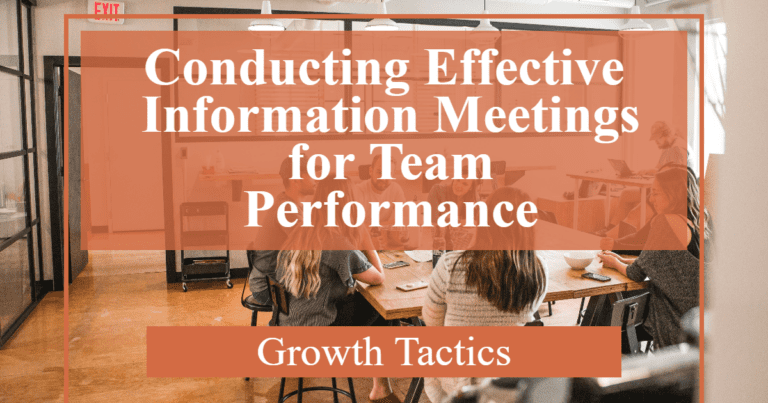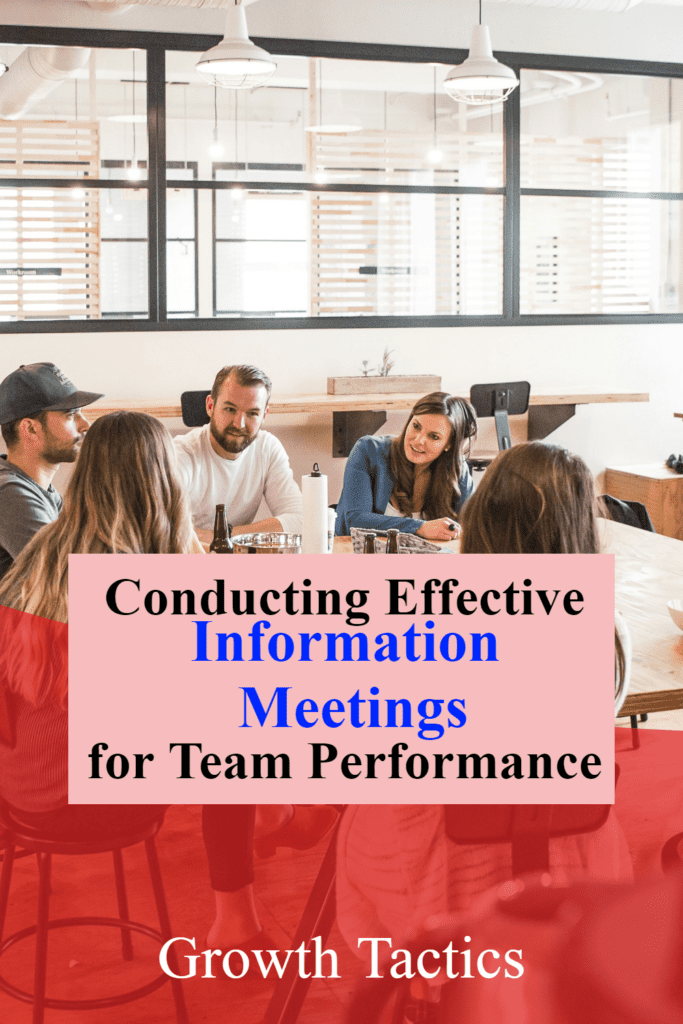Information meetings are crucial for team performance. They provide a platform for sharing updates, discussing matters, and fostering collaboration. In this article, we will explore how to conduct effective information meetings that promote communication, facilitate decision-making, and drive progress. We’ll cover the purpose, preparation, communication strategies, decision-making processes, and the importance of feedback and follow-up. Implementing these techniques will contribute to the overall success of your team.
Jump To Section
1. Purpose and Preparation:
Before scheduling an information meeting, it is essential to establish its purpose. Clarify whether the meeting aims to share important information, provide updates, discuss specific issues, or make decisions. Once the purpose is determined, the next step is to prepare for the meeting effectively.
Creating an agenda is crucial to keep the meeting focused and productive. The agenda should outline the topics to be covered and any supporting materials or information that attendees need to review beforehand. This ensures that everyone is well-prepared and can contribute meaningfully to the discussion.
Additionally, gather any necessary information or data that will be shared during the meeting. This could include progress reports, market research, or financial updates. Having all the necessary information ready in advance will help facilitate a smooth and efficient meeting.
By establishing a clear purpose and thoroughly preparing for the meeting, you set the stage for effective communication, collaboration, and decision-making among the team members.
Next section:
2. Effective Communication Strategies:
To ensure productive and efficient information meetings, it is crucial to employ effective communication strategies. Here are some key strategies to consider:
Clear and concise messaging: When presenting information, be clear and concise in your communication. Avoid using complex jargon or technical terms that may confuse the attendees. Use plain language and provide examples or illustrations to enhance understanding. Keep the discussions focused and avoid going off-topic.
Engage the attendees: Encourage active participation from all attendees to foster a collaborative and inclusive atmosphere. Encourage questions, opinions, and suggestions from the team members. Implement strategies like round-robin sharing or go-around to ensure everyone has an opportunity to express their thoughts.
Active listening: Actively listen to the inputs and feedback provided by the attendees. This demonstrates respect and promotes effective communication. Show interest, maintain eye contact, and ask follow-up questions to gain a deeper understanding of the points being shared.
Visual aids: Utilize visual aids, such as slides, charts, or graphs, to enhance understanding and engagement. Visual representations can help convey complex information more effectively. Ensure that the visuals are clear, well-designed, and support the key messages being discussed.
Adjusting communication styles: Take into account the diverse communication styles and preferences of the team members. Some individuals may prefer written instructions, while others might respond better to visual or verbal explanations. Be adaptable and tailor your communication style to ensure maximum comprehension and engagement.
Implementing these communication strategies will help create a collaborative and engaging environment during information meetings, fostering effective communication and ensuring that all attendees are actively involved in the discussions.
3. Decision-Making Processes:
Information meetings often involve making important decisions that impact the team or organization. To facilitate effective decision-making, it is essential to establish clear processes and frameworks. Here are some key considerations:
Define decision-making criteria: Clearly define the criteria that will guide the decision-making process. This includes identifying the goals, objectives, and desired outcomes of the decision. Having clear criteria helps ensure that decisions align with the overall vision and objectives of the team or organization.
Gather relevant information: Before making a decision, gather all relevant information and data. This may involve conducting research, seeking input from subject matter experts, or analyzing previous data. Ensure that the information is accurate, reliable, and comprehensive to make informed decisions.
Encourage diverse perspectives: Encourage team members to offer diverse perspectives and viewpoints during the decision-making process. This can be achieved through open discussions, brainstorming sessions, or seeking input from different stakeholders. Diverse perspectives can lead to more robust decision-making and minimize bias or blind spots.
Evaluate options: Assess the available options and potential outcomes. Consider the advantages, disadvantages, risks, and benefits associated with each option. Use analytical tools or frameworks, such as SWOT analysis or decision matrices, to evaluate the options objectively.
Facilitate consensus-building: In cases where the decision involves multiple stakeholders, aim for consensus-building. Encourage open dialogue, active listening, and compromise to reach a decision that satisfies the interests and concerns of all parties involved. It may be necessary to facilitate further discussions or negotiations to achieve consensus.
Assign responsibilities and follow-up: Once a decision is made, clearly assign responsibilities and establish a follow-up plan. Clearly communicate the tasks, timelines, and expectations to ensure effective implementation of the decision. Regularly review progress and provide necessary support or adjustments as needed.
By establishing clear decision-making processes, involving diverse perspectives, and ensuring effective implementation, the information meetings can contribute to making well-informed decisions that drive the success of the team or organization.
4. Continuous Improvement:
To ensure the effectiveness and success of information meetings, it is crucial to evaluate and improve the process continuously. Here are some strategies for continuous improvement:
Solicit feedback: Regularly request feedback from meeting attendees to understand their experience and gather suggestions for improvement. This can be done through surveys, one-on-one conversations, or anonymous feedback forms. Analyze the feedback received and identify areas for refinement.
Review meeting structure and timing: Assess the structure and timing of the meetings to determine if they are conducive to productive discussions and decision-making. Consider the length of the meetings, the order of agenda items, and the level of participation. Make adjustments as necessary to optimize efficiency.
Incorporate technology: Explore the use of technology tools to enhance the information meeting experience. This could include using collaboration software for real-time document sharing, utilizing video conferencing platforms for remote attendees, or implementing interactive polling tools to gather instant feedback.
Evaluate meeting outcomes: Assess the outcomes and impact of information meetings. Did the meetings contribute to achieving the desired objectives? Were decisions effectively implemented? Use key performance indicators or metrics to measure the success of the meetings and identify areas for improvement.
Training and development: Invest in training and development opportunities for meeting facilitators and participants. Provide resources and workshops on effective communication, decision-making, and meeting management. This helps build the skills and knowledge necessary for productive information meetings.
Regular review and adjustment: Implement a regular review process for information meetings. This could be done quarterly, biannually, or annually. Evaluate the effectiveness of the meeting format, communication strategies, decision-making processes, and follow-up actions. Make adjustments and incorporate improvements based on the findings.
By embracing a culture of continuous improvement, you can enhance the effectiveness and impact of information meetings over time. Regularly soliciting feedback, evaluating outcomes, and making necessary adjustments ensure that the meetings remain valuable and contribute to the overall success of the team or organization.
5. Best Practices for Information Meetings:
To ensure information meetings are effective and productive, it is helpful to follow some best practices. Here are some key practices to consider:
Clear communication: Clearly communicate the purpose, agenda, and expectations of the meeting to all attendees in advance. This helps set the stage for focused discussions and ensures everyone comes prepared.
Time management: Respect the time of all attendees by starting and ending the meeting on time. Stick to the agenda and allocate appropriate time for each agenda item. Avoid unnecessary tangents or discussions that are not relevant to the meeting objectives.
Active participation: Encourage active participation from all attendees. Create a positive and inclusive environment where individuals feel comfortable sharing their ideas and perspectives. Encourage open dialogue, ask for input, and actively listen to different viewpoints.
Visual aids and materials: Utilize visual aids, such as slides or charts, to support and enhance the presentation of information. Provide relevant materials or documents in advance to give attendees time to review and come prepared with questions or comments.
Use effective facilitation techniques: As the meeting facilitator, employ effective techniques to keep the meeting structured and on track. This includes guiding the discussion, summarizing key points, encouraging participation, and managing any conflicts or disagreements that may arise.
Keep the meeting focused: Stay focused on the meeting objectives and avoid going off-topic. If discussions veer off track, gently redirect the conversation back to the main agenda items. If a tangential discussion is valuable but not immediately relevant, suggest scheduling it for a separate meeting to maintain the focus and efficiency of the current meeting.
Follow up and follow through: Ensure that action items, decisions, and directives that arise during the meeting are documented and followed through. Assign responsibilities and establish clear timelines for completion. Regularly follow up to ensure tasks are progressing as planned.
Evaluate meeting effectiveness: Periodically assess the effectiveness of the information meetings by seeking feedback from attendees and reviewing meeting outcomes. Use the feedback to make adjustments and improvements in future meetings.
By adopting these best practices, you can maximize the effectiveness of information meetings, promote collaboration and engagement, and achieve the desired outcomes of the meetings.
Conclusion
In conclusion, information meetings are crucial for sharing updates and making informed decisions. By following a structured approach, clear communication, effective facilitation, and thorough follow-up, these meetings can be valuable tools for organizations. Continuous improvement and best practices ensure productive and efficient meetings that contribute to overall success. Information meetings become catalysts for effective communication, collaboration, and decision-making within an organization.


